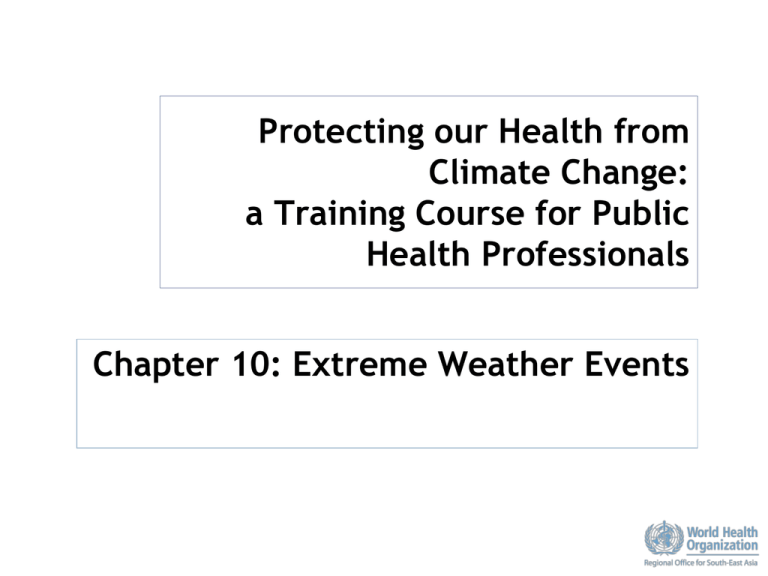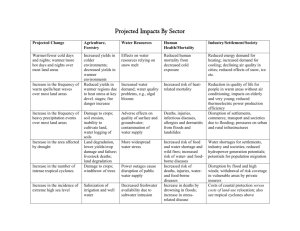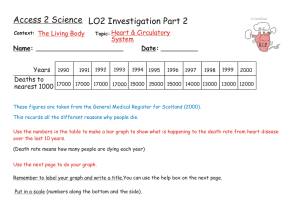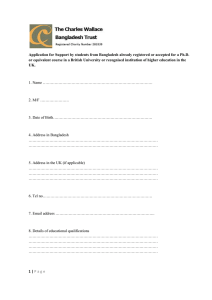Protecting our Health from Climate Change: a Training Course for Public Health Professionals
advertisement

Protecting our Health from Climate Change: a Training Course for Public Health Professionals Chapter 10: Extreme Weather Events Overview: This Module Categories of extreme weather events considered How extreme weather events threaten public health Nature of public health impacts with extreme weather events Current health risks and impacts from extreme weather events in South East Asia Future risks and potential health impacts from climate change Conclusions Extreme Weather Events Considered All extreme weather events currently experienced in countries of South East Asia could be affected by climate change – – – – – – Typhoons Floods Precipitation extremes Wildfires Temperature extremes Others (windstorms, blizzards, etc.) Example: Cyclone Nargis Hits Myanmar in 2008 New York Times, 2008 The Guardian, 2008 Example of Flooding: Bangladesh 2004 Residents with food during a 2004 flood in Bangladesh BSA-UA, 2004 Extreme Weather Events Considered Focus on typhoons/cyclones, extreme precipitation/floods, and wildfires because – They pose a significant health risk – They have a long history of substantial adverse health impacts – They are the focus of considerable climate change-related research – They are a focus of current adaptation efforts How Extreme Weather Events Threaten Public Health The health risks/impacts of an extreme weather event are a function of: – Severity: how challenging are the event’s conditions (e.g., cyclone winds over 120 mph) – Duration: how long are the extreme conditions experienced – Surprise: how much advance warning was available for the event (e.g., days, hours, minutes) There are differences in categories of events There will be differences between individual events within a category Global Warming in Increasing the Risk of Extreme Weather Events Population Characteristics Affect Risks/Impacts of Extreme Weather Population factors affecting the risks/impacts of extreme weather events include – Size: how many people does the event affect – Age: the young and old are less able to help themselves in an extreme weather event – Health status: poor health limits individuals’ response ability – Wealth: poverty can limit the types of preparation actions and responses that can be considered, it can also affect exposure (e.g., housing stock) Types of Public Health Impacts from Extreme Weather Events Direct health impacts – Morbidity – Mortality • Both are observable and clearly attributable to the physical impacts of the event: – Mental health impacts (Post Traumatic Stress Disorder-PTSD, depression) • Delayed onset and recognition can lead to impacts being missed in an event summary • Potential to adversely affect productivity • Potential for severe health and quality of life impacts Nature of Public Health Impacts with Extreme Weather Events Indirect health impacts – Can be less observable – Can take time to develop – May reflect a loss of access to critical resources: clean water, shelter – Can result from disruption to routines: • Restricted access to, or supply of, medicine, caregivers, medical facilities Overview of Extreme Weather Event Health Impacts Extreme weather events have a history of significant health impacts in many Asian countries Impact summaries focus on mortality but significant morbidity is associated with the underlying events Totals and “average” event impacts obscure the skewed nature of the impacts data – Results can be driven by impacts of a single event – Impacts from repeated, smaller events can be as significant as a major extreme event Deaths from Extreme Weather Events 1970-2008: Example South East Asia SEARO country Drought Bangladesh 18 Bhutan (no pre-1990 data) India 320 Indonesia 1,329 Korea Dem P Rep Korea Rep Maldives Myanmar Nepal Sri Lanka Thailand Timor-Leste (no pre-1990 data) Total 1,667 Extreme temperature Flood Storm Wildfire Total 2,171 41,759 474,098 518,046 222 17 239 11,710 46,185 49,029 6 107,250 5,227 1,692 300 8,548 1,820 55 1,875 40 2,274 2,186 2 4,502 364 138,864 8 139,236 108 5,481 97 88 5,774 941 754 1,695 2,648 927 3,575 1 1 14,029 106,922 667,719 404 790,741 Impacts not equally distributed by country or type of extreme event. Nearly 800,000 reported deaths. Storm mortality 84% of total. EMDAT, 2008 Mortality from Extreme Weather: Example South East Asia 70.0% 60.0% 50.0% 40.0% 30.0% 20.0% 10.0% Th ai la nd Ti m or -L es te N ep al S ri La nk a In do ne si D a em P R ep K or ea R ep M al di ve s M ya nm ar In di a hu ta n K or ea B B de sh 0.0% an gl a % of all EM-Dat deaths 1970-2008 (list events) % deaths by country in SEA region from climate sensitive extreme events 1970-2008 Country Bangladesh is the key to mortality impacts to SEARO from extreme weather events EMDAT, 2008 Health Impacts by Type of Extreme Event: Example South East Asia % SEA region deaths in EMDAT 1970-2008 by event type 90.0% 80.0% % reported deaths 70.0% 60.0% 50.0% 40.0% 30.0% 20.0% 10.0% 0.0% Drought Extreme temperature Flood Storm Wildfire Type of Climate Sensitive Extreme Event This graph highlights the relative importance of storms EMDAT, 2008 Importance of Single Events in Health Impacts of Extreme Weather Events While appropriate to summarize health impacts of extreme weather events it would be inappropriate to try and convey a sense of “average” impacts over time These events have extremely variable health impacts Totals are driven by a few events The strongest events may not have the highest health impact Distribution of Health Impacts by Event: U.S. Hurricane Deaths 10000 2005, Dennis, Katrina, Rita, and Wilma 2,002 deaths Galveston, 1900, ~8,000 deaths Deaths per year from hurricanes 1000 100 10 Mills, 2009 U.S. hurricane death totals are driven by single storm impacts 20 07 19 97 19 87 19 77 19 67 19 57 19 47 19 37 19 27 19 17 19 07 18 97 1 Importance of Single Extreme Weather Events in South East Asia 73% of all reported extreme weather event deaths, roughly 77,000, in countries of South East Asia from 1970-2008 are from three cyclones – November, 1970 (unnamed): 300,000 killed in Bangladesh – April, 1991 (Gorky): 139,000 killed in Bangladesh – May, 2008 (Nargis): 137,500 killed in Myanmar EMDAT, 2008 Current Mortality Impacts of Flooding: Cartogram Results Cartograms – Re-weight a country’s land area as a percentage of the variable in question – For health outcomes • Larger countries/regions account for more of the health impact in question (e.g., deaths from a cause or cases of an illness) • For evidence of a relatively high or disproportionate impacts compare cartograms for the health outcome with cartograms of population Cartogram Baseline Now: World Population in 2000 Countries’ areas are re-weighted according to the size of its population: note India and China Worldmapper, 2008a Relative Importance of Floods in SEARO as a Mortality Risk SEARO historically vulnerable to flooding. Note increased size of India and Bangladesh. Worldmapper, 2008d Smoke from Forest and Agricultural Fires in 2006 Fire from smoke results in degraded air quality in Indonesia, Malaysia and Thailand Mongabay.com, 2006 Climate Change and Future Health Impacts of Extreme Weather Events Increase in risk may or may not result in increased health impacts from future extreme weather events – Sensitivity of health impact totals to single events means marginal impacts could have either a minimal or significant health impact – Socio-demographic changes in population location, size, health, wealth likely as significant as impact of climate change on event’s future health impact – Adaptation, in the form of hazard planning, preparation, and response, will play a critical role in determining the magnitude of future health impacts from extreme weather events Caveats to Climate Change and Extreme Weather Events The impact of climate change on extreme weather events will best be measured in terms of changes in frequency and intensity of events These are likely to be marginal changes It is extremely unlikely that a day will come when a single event can be attributed, in its entirety to climate change Examples of Adaptation to Extreme Weather Events Following devastating cyclones Bangladesh has begun constructing cyclone shelters to keep vulnerable residents safe Pitchford, 2008 Goals for Extreme Weather Event Notification and Response Plans Improve public understanding of the magnitude and severity of the risks involved Develop plans for reducing public exposure to the event’s conditions – Evacuation options – Shelters Prepare response plans with clearly defined goals and responsibilities Do not overlook planning for indirect health impacts, they can be significant Health sector to be represented and to participate actively in national climate change committees Goals for Extreme Weather Event Notification and Response Plans (cont.) Develop hypothetical scenarios and practice (i.e., tabletop exercises) Draw on past experience Be flexible in response to unanticipated constraints and opportunities during actual events Be open to outside assistance that has the potential to improve public health Extreme Weather Event Response: Providing/Receiving Assistance The Guardian, 2008 Conclusions Extreme weather events already present a significant health risk to countries in South East Asia based on a history of significant impacts Climate change may increase the frequency and/or severity of many of those events, – Storms/cyclones – Flooding Detecting the climate change signal or marginal impact in any given event may be impossible given natural variation Conclusions (cont.) Ultimate health impact of extreme events with climate change is uncertain – Totals driven mainly by a limited number of individual events Changes in factors other than climate change will also be critical in determining the nature and extent of future health impacts – Population size, health, wealth, location Effective adaptation (e.g., education, notification, and response plans) could limit future adverse health impacts Conclusions (cont.) Uncertainty over future arguments is not an argument for doing nothing Uncertainty with anticipated increase in risk from the nature of the events argues for increased efforts to prepare for future extreme weather events



